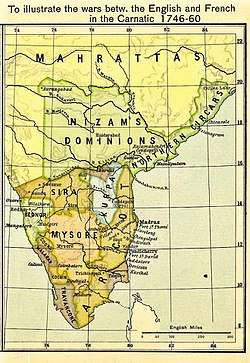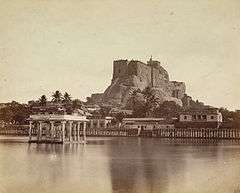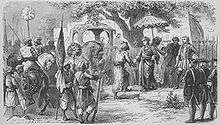Siege of Trichinopoly (1743)
The Siege of Trichinopoly (March 1743 - August 1743) took place at Trichinopoly, (present day known as Tiruchirappalli-northern and central Tamilnadu, India) during an extended series of conflicts between the Nizam of Hyderabad and the Maratha Empire for control over Carnatic region. Deccan region which comprises of six Mughal Empire governorates-(Subahs) Khandesh, Bijapur, Malwa, Aurangabad, Hyderabad and Carnatic of which Nizam-ul-Mulk-(also known as Nizam) was the legitimate Viceroy. In the process to obtain a complete suzerainty over Deccan region, the Nizam besieged the town of Trichinopoly which was governed by Maratha commander Murari Rao Ghorpade under the control of Shahu I. After about six months of siege, the Nizam successfully make Murari Rao to surrender. With this defeat of Maratha's by Nizam came an end of the Maratha's suzerainty in the Carnatic region and the Nizam regain control over Deccan.
| Siege of Trichinopoly (1743) | |||||||
|---|---|---|---|---|---|---|---|
 | |||||||
| |||||||
| Belligerents | |||||||
|
|
| ||||||
| Commanders and leaders | |||||||
| |||||||
| Strength | |||||||
|
2000 Sowars 4000 Sepoy |
80,000 Sowars 200,000 Sepoy | ||||||
| Casualties and losses | |||||||
| unknown | unknown | ||||||
By the end of 1743, the Nizam regain full control of Deccan region which comprises of six governorates-(Subahs), he resorted the Marathas interference in Deccan region, had overthrow the internal rebellion of regional governors and closely monitored the activities of British East India company and French East India Company by restricting there access upto ports outposts and trading.
However during the last years of Nizam and after his death in 1748, the Deccan became the center of a power struggle which had lead to a series of complicated three Carnatic Wars (1746-1763), claimant of Nizam succession were among the Nizam’s own sons and grandsons-Nasir Jung, Salabat Jung and Muzaffar Jung, between the Maratha Peshwa-Raghoji I Bhonsle and Balaji Bajirao, and for the title of the Nawab of Arcot between Chanda Saheb and Muhammed Ali Khan Wallajah, and between the legitimate ruler of Mysore Krishnaraja and DeFacto Hyder Ali, eventually they all were supported by either Frenchman Joseph François Dupleix or the British Robert Clive though they were each other's rival and had increased there interference and influence among the local rulers and there opponents.
History
In 1714 Farrukhsiyar, the Mughal emperor, appointed Asaf Jah I as his Viceroy of the Deccan that comprises six governorates-(known as Subahs) which are Khandesh, Bijapur, Malwa, Aurangabad, Hyderabad and Carnatic, with the title Nizam-ul-Mulk (Administrator of the Realm).[1]:143[2]:100:105[3]:95 In 1724, Asaf Jah I defeated Mubariz Khan to establish autonomy over the Deccan Suba, named the region Hyderabad Deccan, and started what came to be known as the Asaf Jahi dynasty. He retained the title Nizam ul-Mulk and was referred to as Asaf Jahi Nizams or more commonly as Nizam of Hyderabad.[4]:241:260[5] Thus since then the Carnatic region became his feudatory.[6]:98[7]:298:310
Background

In the 1720s, the Carnatic region of southern India was autonomous dominion of Mughal empire under the suzerainty of Asaf Jah 1, the Nizam of Hyderabad. The Nizam had appointed Muhammed Saadatullah Khan as Nawab of the Carnatic in 1710. Saadatullah died in 1732, directing that he be succeeded by his nephew, Dost Ali Khan.[6]:97:98
Tukkoji Bhonsle a Maratha ruler of Trichinopoly died in 1736, leaving a son Ekoji II to succeeded him and a wife rani Minakshi who was acting as regent for her young son. Dost Ali sent his son-in-law and diwan, Chanda Sahib, to the province, claiming its tribute payments were in arrears. He inveigled himself into the court of rani Minakshi. Abusing her trust, he seized the fortress and threw her into prison, where she died of grief. Dost Ali rewarded Chanda Sahib with the title Nawab of Trichinopoly in 1739, this decisive act and the refusal of tributary payment Chauth by Dost Ali Khan enraged the Marathas, they utilized the absence of Nizam in Deccan due to his engagement in resolving disputes in the North India, in 1740 the Maratha army of 50,000 invaded Carnatic region under the command of Raghoji I Bhonsle, and in a battle at Damalcherry-(a pass near Arcot) Dost Ali Khan was killed. Dost Ali's son and successor Safdar Ali Khan negotiated and agreed a tribute payment to the Marathas. Confidant of his defense Chanda saheb was adamant to negotiate with Raghoji I Bhonsle and refused to; pay tribute and surrender Trichinopoly. Raghoji I Bhonsle siege Trichinopoly initially Chanda Saheb resisted the siege, marathas bribed a officer who had betrayed Chanda Saheb and left a free opening to the Maratha army through very important mountain post, Marathas occupied Trichinopoly and took Chanda Sahab as a prisoner to Satara. Murari Rao was installed as Maratha governor of Trichinopoly in 1741.[8]:150:151[6]:98:100[9]:276:278[10]:41:42
In 1741, when Safdar Ali proclaimed the Nawab of Carnatic, the Nizam who had just returned back from Delhi after resolving the settlement between Muhammad Shah and Nadir Shah who had invaded Delhi, Nizam demanded Safdar Ali to settle due arrears of Subah Deccan. Safdar Ali who had recently negotiated Marathas with an agreement of the indemnity and tributary payments, was hardly in a position to meet the demands of the Nizam and the Maraths. To encounter this double payments he imposed new cess and demanded additional levy from his regions town administrators. Safdar Ali’s brother-in-law Nawab Muruza Ali Khan an administrator of Vellore refused to pay increased levied and prepared a plot along with his wife-(who was also sister of Safdar Ali) and coped to murder Safdar Ali, he proclaimed himself as the Nawab of the Carnatic, which irked other nobles and they brought Nawab Saeed Muhammad Khan-(who was in Madras) son of Safdar Ali to proclaim as the Nawab of the Carnatic.[11]:2:5
Siege
-during-CarnaticWars1751.jpg)
In 1742, the Nizam who was busy in the affairs at Delhi and had just returned to the Deccan. After the invasion of Nadir Shah in Delhi the Mughals were in no position to stop the Marathas in Carnatic region-(south east India), the Nizam was enraged to see the rebellion of Nawab of Arcot and Maratha occupation of Carnatic region particularly Trichinopoly, while he was contemplating an invasion of Carnatic region to reestablish his authority as Viceroy of Deccan, Dalavayi Devarajaiya of Mysore when came to know he joined the Nizam to take back Trichinopoly from the Maratha's, for which in January 1743 he made and agreement with the Nizam to pay 10,000,000 ₹s if the latter would bring Trichinopoly under Mysore. In February 1743 the Nizam marched towards Carnatic region from Hyderabad.[12]:74:75[13]:81[14]
After deposing Muhammed Saadatullah Khan II in Arcot, the Nizam marched towards Trichinopoly, in March 1743 he reached Trichinopoly with an army of 200,000 sepoy, 80,000 Sowar and some 150 War elephant. Maratha governor Murari Rao Ghorpade who held Trichinopoly from July 1741 could not show much resistance but refused to surrender, thus the Nizam laid siege to Trichinopoly, he blocked and disconnected the supply line of Maratha aid, Murari Rao could not hold for long; he ran-over stocks, his army stationed in Trichinopoly for the defense of fort was less-(4000 Sepoy and 2000 Sowars)[15] when compared to opponents, he could not expect any reinforcement from his Maratha superiors as they themselves were indulge in internal conflicts between the Maratha ruler Raghoji I Bhonsle and his Peshwa Balaji Baji Rao. Thus Murari Rao surrendered to the Nizam, and came to the terms of agreement in which the Nizam offered him governance of the hill-fort of Penukonda, jagir around the fort and 200,000 ₹s in cash. The siege ended after 6 Months on 29 August 1743. The surrender of Trichinopoly brought an end to the Maratha suzerainty over the Carnatic region, by which they lost direct rule over the region, and Nizam once again regain the authority over the Deccan region.[12]:74:75[13]:81[16]:69:73[17]:1034
As per agreement of Trichinopoly-(between Dalavayi Devarajaiya of Mysore and Nizam of Hyderabad that happened in January 1743); if Dalavayi want control of Trichinopoly he had to pay 10,000,000 ₹s to the Nizam, but the Dalavoy could not pay the sum as he was suffering with the financial crisis after paying heavy tributary taxes-(which include 50,000,000 ₹s) to Maratha ruler Raghuji in 1740-1741 after Maratha invasion of carnatic region. Thus in October 1743, the Nizam therefore appointed Nawab Anwaruddin Khan of Arcot as in charge of Trichinopoly and left for Golconda.[18]:267
Aftermath
When Nizam took full control of Trichinopoly in September 1743.[16]:43:79[19]:52:53 Nizam appointed Khwaja Abdullah as the ruler and returned to Golkonda.[2]:103 When the Nawab of the Carnatic Muhammed Ali Khan Wallajah was dethroned by Chanda Sahib after the Battle of Ambur in 1749, the former took refuge in Tiruchirappalli, where he set up his base.[20]:126:127[21]:222[16]:115 The subsequent siege of Trichinopoly (1751–1752) by Chanda Sahib took place during the Second Carnatic War between the British East India Company and Muhammed Ali Khan Wallajah on one side and Chanda Sahib and the French East India Company on the other.[16]:148 The British were victorious and Wallajah was restored to the throne as Nawab of Arcot. During his reign he proposed renaming the city Natharnagar after the Sufi saint Nathar Vali, who is thought to have lived there in the 12th century AD.[22]:233[23]:137
From 1744-46 two expenditure were sent by Shahu I to expand the Maratha supremacy over the Carnatic affairs; first being lead by Babuji Naik of Baramati and was defeated after he confronted by Anwaruddin Khan of Arcot and Muzaffar Jung assigned by the Nizam. Second expedition was in 1746 and to be leaded by Babuji Naik and Fateh Singh Bhonsle of Akkalkot who were again unsuccessful to take back Trichinopoly and were defeated by the Nizam's army.[1]:143[2]:100:105[24]:30:35[9] Three years after the siege, in 1746, Marathas under Peshwa Balaji Bajirao sent a military expedition to Carnatic, led by Sadashivrao Bhau. The Maratha army overran the region and brought it under their control. Nizam's army, under Nasir Jung tried to obstruct the Marathas, but was defeated and repulsed by Sadashivrao Bhau. Maratha influence in the region was replaced by the French and British forces.[1]:143[2]:100:105
By 1745, Nizam-ul-Mulk established Hyderabad as an independent kingdom. The coastal Carnatic region was a dependency of Hyderabad, a power struggle ensued after his death between his son, Nasir Jung, and his grandson, Muzaffar Jung, which was the opportunity France and England needed to interfere in Indian politics. France aided Muzaffar Jung while England aided Nasir Jung. Several erstwhile Mughal territories were autonomous such as the Carnatic, ruled by Nawab appointed under the suzerainty of Nizam, despite being under the legal purview of the Nizam of Hyderabad. French and English interference included those of the affairs of the Nawab which instigated and lead to the Three Carnatic Wars that were a series of wars fought between 1746 and 1763 among the Maratha-(two Peshwas with differences Raghoji I Bhonsale and Balaji Bajirao), the Nizam of Hyderabad-(two contenders Nasir Jung and Muzaffar Jung), the Nawab of Arcot-(two contenders Chanda Saheb and Muhammed Ali Khan Wallajah), British-(Robert Clive) and French-(Joseph François Dupleix). They all keep changing support system between one another during and after war.[8]:150:159
References
- Mehta, Jaswant Lal (2005). Advanced Study in the History of Modern India: 1707–1813. Sterling Publishing. ISBN 978-1-932705-54-6.
- Chhabra, G.S. (2005). Advanced Study in the History of Modern India: 1707–1813. I. Lotus Press. ISBN 978-1-932705-54-6. Retrieved 12 August 2020.
- Roy, Olivier (2011). Holy Ignorance: When Religion and Culture Part Ways. Columbia University Press. ISBN 978-0-231-80042-6.
- Richards, J. F. (1975). "The Hyderabad Karnatik, 1687–1707". Modern Asian Studies. 9 (2). doi:10.1017/S0026749X00004996.
- Ikram, S. M. (1964). "A century of political decline: 1707–1803". In Embree, Ainslie T (ed.). Muslim civilization in India. Columbia University. ISBN 978-0-231-02580-5. Retrieved 12 August 2020.
- Rao, Sushil (11 December 2009). "Testing time again for the pearl of Deccan". The Times of India. Archived from the original on 10 September 2015. Retrieved 22 April 2012.
- Mackenna, P. J.; Taylor, William Cooke (2008). Ancient and Modern India. Wertheimer and Company. Retrieved 5 August 2020.
- Corner(Julia), Miss (1847). The History of China & India: Pictorial and Descriptive (PDF). H. Washbourne. Retrieved 12 August 2020.
- Naravane, M.S. (2014). Battles of the Honorourable East India Company. A.P.H. Publishing Corporation. ISBN 9788131300343.
- Chandramauliswar, R. (1953). "Maratha invasion of the Madura country (1740-1745)". 16. Jstor. Retrieved 4 August 2020. Cite journal requires
|journal=(help) - Brackenbury, C.F (2000). District Gazetteer, Cuddapah. Asian Educational Services. ISBN 9788120614826. Retrieved 11 August 2020.
- Nizam-British Relations, 1724–1857 at Google Books
- Illustrated Guide to the South Indian Railway. Asian Educational Services. 1926. ISBN 9788120618893. Retrieved 4 August 2020.
- Black, Jeremy (2012). War in the Eighteenth-Century World. Macmillan International Higher Education. ISBN 9788120618893. Retrieved 11 August 2020.
- Rajayyan, K. "THE MARATHAS AT TRICHINOPOLY : 1741-1743." Annals of the Bhandarkar Oriental Research Institute 51, no. 1/4 (1970): 222-30. Accessed August 14, 2020. www.jstor.org/stable/41688690.
- Chand, S (2009). The Cambridge History of India. 4. The University of Michigan. p. 384. Retrieved 4 August 2020.
- Ramaswami, N.S (1984). Political History of Carnatic Under the Nawabs. Abhinav Publications. ISBN 9780836412628. Retrieved 12 August 2020.
- Jaques, Tony (2007). Dictionary of Battles and Sieges. Greenwood Publishing Group. ISBN 9780313335396. Retrieved 4 August 2020.
- Raj, Raghavendra (2004). "Early wodeyars of Mysore and Tamil nadu a study in political economic and cultural relations (Dalvoys relations with Tamil Nadu (1704-1761))". University of Mysore (Department of History). Retrieved 13 August 2020. Cite journal requires
|journal=(help);|chapter=ignored (help) - Subramanian, K. R. (1928). The Maratha Rajas of Tanjore. Madras: K. R. Subramanian.
- Rose, John Holland; Newton, Arthur Percival (1929). The Cambridge History of the British Empire. CUP Archive. GGKEY:55QQ9L73P70. Retrieved 12 August 2020.
- Markovits, Claude (2004). A History of Modern India, 1480–1950. Anthem Press. ISBN 978-1-84331-152-2.CS1 maint: ref=harv (link)
- Bayly, Susan (2004). Saints, Goddesses and Kings: Muslims and Christians in South Indian Society, 1700–1900. Cambridge University Press. ISBN 978-0-521-89103-5. Retrieved 12 August 2020.
- Muthiah, S. (2008). Madras, Chennai: A 400-year Record of the First City of Modern India. Palaniappa Brothers. ISBN 978-81-8379-468-8. Retrieved 12 August 2020.
- Chitnis, Krishnaji Nageshrao (2000). The Nawabs of Savanur. Atlantic Publishers. ISBN 9788171565214. Retrieved 4 August 2020.
